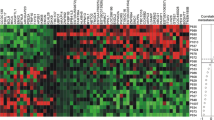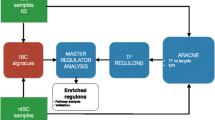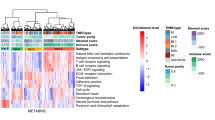Abstract
The goal of this study was to determine whether gene expression differences exist between inflammatory breast cancers (IBC) and T stage-matched non-IBC patients stratified by hormone receptor and HER2 status. We used Affymetrix GeneChips to analyze 82 tumor samples (25 T4d patients, and 57 T4a-c patients) of newly diagnosed breast cancers. Genes that were differentially expressed between the IBC and non-IBC specimens were identified using the t test, and differential expression of gene sets was assessed using gene set analysis. Three distinct clinical subtypes of IBC and non-IBC were compared: ER-positive/HER2-normal, HER2-amplified, and ER-negative/HER2-normal. When we compared expression data from all IBC with all non-IBC, we found no significant differences after adjusting for multiple testing. When IBC and non-IBC tumors were compared by clinical subtype, however, significant differences emerged. Complement and immune system-related pathways were overexpressed in ER-positive/HER2-normal IBC. Protein translation and mTOR signaling were overexpressed in HER2-amplified IBC. Apoptosis-, neural-, and lipid metabolism-related pathways were overexpressed in ER-negative/HER2-normal IBC compared with non-IBC of the same receptor phenotype. In this T stage-matched case–control study, the survival curves of patients with IBC and non-IBC were similar for all three clinical subtypes. IBC tumors can be divided into molecular and clinical subtypes similar to those of non-IBC. Clinical subtypes of IBC show molecular differences compared with similar subtypes of non-IBC.


Similar content being viewed by others
Abbreviations
- IBC:
-
Inflammatory breast cancers
- FNA:
-
Fine needle aspiration
- GEO:
-
Gene expression omnibus
- ER:
-
Estrogen receptor
- HER2:
-
Human epidermal growth factor Receptor 2
- FDR:
-
False discovery rates
- SAM:
-
Significance analysis of microarrays
- IPA:
-
Ingenuity pathway analysis software
- GSA:
-
Gene set analysis
- RT-PCR:
-
Reverse transcription polymerase chain reaction
- mTOR:
-
Mammalian target of rapamycin
References
Singletary SE, Allred C, Ashley P, Bassett LW, Berry D, Bland KI, Borgen PI, Clark G, Edge SB, Hayes DF, Hughes LL, Hutter RV, Morrow M, Page DL, Recht A, Theriault RL, Thor A, Weaver DL, Wieand HS, Greene FL (2002) Revision of the American joint committee on cancer staging system for breast cancer. J Clin Oncol 20(17):3628–3636
Levine PH, Steinhorn SC, Ries LG, Aron JL (1985) Inflammatory breast cancer: the experience of the surveillance, epidemiology, and end results (seer) program. J Natl Cancer Inst 74(2):291–297
Cristofanilli M, Buzdar AU, Hortobagyi GN (2003) Update on the management of inflammatory breast cancer. Oncologist 8(2):141–148
Bieche I, Lerebours F, Tozlu S, Espie M, Marty M, Lidereau R (2004) Molecular profiling of inflammatory breast cancer: identification of a poor-prognosis gene expression signature. Clin Cancer Res 10(20):6789–6795. doi:10.1158/1078-0432.CCR-04-0306
Bertucci F, Finetti P, Rougemont J, Charafe-Jauffret E, Cervera N, Tarpin C, Nguyen C, Xerri L, Houlgatte R, Jacquemier J, Viens P, Birnbaum D (2005) Gene expression profiling identifies molecular subtypes of inflammatory breast cancer. Cancer Res 65(6):2170–2178. doi:10.1158/0008-5472.CAN-04-4115
Nguyen DM, Sam K, Tsimelzon A, Li X, Wong H, Mohsin S, Clark GM, Hilsenbeck SG, Elledge RM, Allred DC, O’Connell P, Chang JC (2006) Molecular heterogeneity of inflammatory breast cancer: a hyperproliferative phenotype. Clin Cancer Res 12(17):5047–5054. doi:10.1158/1078-0432.CCR-05-2248
Van Laere S, Van der Auwera I, Van den Eynden G, Van Hummelen P, van Dam P, Van Marck E, Vermeulen PB, Dirix L (2007) Distinct molecular phenotype of inflammatory breast cancer compared to non-inflammatory breast cancer using affymetrix-based genome-wide gene-expression analysis. Br J Cancer 97(8):1165–1174. doi:10.1038/sj.bjc.6603967
Hess KR, Anderson K, Symmans WF, Valero V, Ibrahim N, Mejia JA, Booser D, Theriault RL, Buzdar AU, Dempsey PJ, Rouzier R, Sneige N, Ross JS, Vidaurre T, Gomez HL, Hortobagyi GN, Pusztai L (2006) Pharmacogenomic predictor of sensitivity to preoperative chemotherapy with paclitaxel and fluorouracil, doxorubicin, and cyclophosphamide in breast cancer. J Clin Oncol 24(26):4236–4244. doi:10.1200/JCO.2006.05.6861
Gong Y, Yan K, Lin F, Anderson K, Sotiriou C, Andre F, Holmes FA, Valero V, Booser D, Pippen JE Jr, Vukelja S, Gomez H, Mejia J, Barajas LJ, Hess KR, Sneige N, Hortobagyi GN, Pusztai L, Symmans WF (2007) Determination of oestrogen-receptor status and Erbb2 status of breast carcinoma: a gene-expression profiling study. Lancet Oncol 8(3):203–211. doi:10.1016/S1470-2045(07)70042-6
Parker JS, Mullins M, Cheang MC, Leung S, Voduc D, Vickery T, Davies S, Fauron C, He X, Hu Z, Quackenbush JF, Stijleman IJ, Palazzo J, Marron JS, Nobel AB, Mardis E, Nielsen TO, Ellis MJ, Perou CM, Bernard PS (2009) Supervised risk predictor of breast cancer based on intrinsic subtypes. J Clin Oncol 27(8):1160–1167. doi:10.1200/JCO.2008.18.1370
Tusher VG, Tibshirani R, Chu G (2001) Significance analysis of microarrays applied to the ionizing radiation response. Proc Natl Acad Sci USA 98(9):5116–5121. doi:10.1073/pnas.091062498
Subramanian A, Tamayo P, Mootha VK, Mukherjee S, Ebert BL, Gillette MA, Paulovich A, Pomeroy SL, Golub TR, Lander ES, Mesirov JP (2005) Gene set enrichment analysis: a knowledge-based approach for interpreting genome-wide expression profiles. Proc Natl Acad Sci USA 102(43):15545–15550. doi:10.1073/pnas.0506580102
Van Laere S, Van der Auwera I, Van den Eynden GG, Fox SB, Bianchi F, Harris AL, van Dam P, Van Marck EA, Vermeulen PB, Dirix LY (2005) Distinct molecular signature of inflammatory breast cancer by cdna microarray analysis. Breast Cancer Res Treat 93(3):237–246. doi:10.1007/s10549-005-5157-z
Bertucci F, Finetti P, Rougemont J, Charafe-Jauffret E, Nasser V, Loriod B, Camerlo J, Tagett R, Tarpin C, Houvenaeghel G, Nguyen C, Maraninchi D, Jacquemier J, Houlgatte R, Birnbaum D, Viens P (2004) Gene expression profiling for molecular characterization of inflammatory breast cancer and prediction of response to chemotherapy. Cancer Res 64(23):8558–8565. doi:10.1158/0008-5472.CAN-04-2696
DiMeo TA, Anderson K, Phadke P, Feng C, Perou CM, Naber S, Kuperwasser C (2009) A novel lung metastasis signature links Wnt signaling with cancer cell self-renewal and epithelial-mesenchymal transition in basal-like breast cancer. Cancer Res 69(13):5364–5373. doi:10.1158/0008-5472.CAN-08-4135
Shipitsin M, Campbell LL, Argani P, Weremowicz S, Bloushtain-Qimron N, Yao J, Nikolskaya T, Serebryiskaya T, Beroukhim R, Hu M, Halushka MK, Sukumar S, Parker LM, Anderson KS, Harris LN, Garber JE, Richardson AL, Schnitt SJ, Nikolsky Y, Gelman RS, Polyak K (2007) Molecular definition of breast tumor heterogeneity. Cancer Cell 11(3):259–273. doi:10.1016/j.ccr.2007.01.013
Jiang Z, Gentleman R (2007) Extensions to gene set enrichment. Bioinformatics 23(3):306–313. doi:10.1093/bioinformatics/btl599
Efron B, Tishirani R (2007) On testing the significance of sets of genes. Ann Appl Stat 1(1):107–129
Silvera D, Arju R, Darvishian F, Levine PH, Zolfaghari L, Goldberg J, Hochman T, Formenti SC, Schneider RJ (2009) Essential role for eIF4GI overexpression in the pathogenesis of inflammatory breast cancer. Nat Cell Biol 11(7):903–908. doi:10.1038/ncb1900
Forozan F, Veldman R, Ammerman CA, Parsa NZ, Kallioniemi A, Kallioniemi OP, Ethier SP (1999) Molecular cytogenetic analysis of 11 new breast cancer cell lines. Br J Cancer 81(8):1328–1334. doi:10.1038/sj.bjc.6695007
Piccart-Gebhart MJ, Procter M, Leyland-Jones B, Goldhirsch A, Untch M, Smith I, Gianni L, Baselga J, Bell R, Jackisch C, Cameron D, Dowsett M, Barrios CH, Steger G, Huang CS, Andersson M, Inbar M, Lichinitser M, Lang I, Nitz U, Iwata H, Thomssen C, Lohrisch C, Suter TM, Ruschoff J, Suto T, Greatorex V, Ward C, Straehle C, McFadden E, Dolci MS, Gelber RD (2005) Trastuzumab after adjuvant chemotherapy in HER2-positive breast cancer. N Engl J Med 353(16):1659–1672. doi:10.1056/NEJMoa052306
Romond EH, Perez EA, Bryant J, Suman VJ, Geyer CE Jr, Davidson NE, Tan-Chiu E, Martino S, Paik S, Kaufman PA, Swain SM, Pisansky TM, Fehrenbacher L, Kutteh LA, Vogel VG, Visscher DW, Yothers G, Jenkins RB, Brown AM, Dakhil SR, Mamounas EP, Lingle WL, Klein PM, Ingle JN, Wolmark N (2005) Trastuzumab plus adjuvant chemotherapy for operable HER2-positive breast cancer. N Engl J Med 353(16):1673–1684. doi:10.1056/NEJMoa052122
Van Pelt AE, Mohsin S, Elledge RM, Hilsenbeck SG, Gutierrez MC, Lucci A Jr, Kalidas M, Granchi T, Scott BG, Allred DC, Chang JC (2003) Neoadjuvant trastuzumab and docetaxel in breast cancer: preliminary results. Clin Breast Cancer 4(5):348–353
Hurley J, Doliny P, Reis I, Silva O, Gomez-Fernandez C, Velez P, Pauletti G, Powell JE, Pegram MD, Slamon DJ (2006) Docetaxel, cisplatin, and trastuzumab as primary systemic therapy for human epidermal growth factor receptor 2-positive locally advanced breast cancer. J Clin Oncol 24(12):1831–1838. doi:10.1200/JCO.2005.02.8886
Limentani SA, Brufsky AM, Erban JK, Jahanzeb M, Lewis D (2007) Phase II study of neoadjuvant docetaxel, vinorelbine, and trastuzumab followed by surgery and adjuvant doxorubicin plus cyclophosphamide in women with human epidermal growth factor receptor 2-overexpressing locally advanced breast cancer. J Clin Oncol 25(10):1232–1238. doi:10.1200/JCO.2005.05.3306
Yamauchi H, Cristofanilli M, Nakamura S, Hortobagyi GN, Ueno NT (2009) Molecular targets for treatment of inflammatory breast cancer. Nat Rev Clin Oncol 6(7):387–394. doi:10.1038/nrclinonc.2009.73
Kaufman B, Trudeau M, Awada A, Blackwell K, Bachelot T, Salazar V, DeSilvio M, Westlund R, Zaks T, Spector N, Johnston S (2009) Lapatinib monotherapy in patients with HER2-overexpressing relapsed or refractory inflammatory breast cancer: final results and survival of the expanded HER2+ cohort in EGF103009, a phase II study. Lancet Oncol 10(6):581–588. doi:10.1016/S1470-2045(09)70087-7
Gelderman KA, Tomlinson S, Ross GD, Gorter A (2004) Complement function in mab-mediated cancer immunotherapy. Trends Immunol 25(3):158–164. doi:10.1016/j.it.2004.01.008S
Nahta R, Yu D, Hung MC, Hortobagyi GN, Esteva FJ (2006) Mechanisms of disease: understanding resistance to HER2-targeted therapy in human breast cancer. Nat Clin Pract Oncol 3(5):269–280. doi:10.1038/ncponc0509
Atkins MB, Hidalgo M, Stadler WM, Logan TF, Dutcher JP, Hudes GR, Park Y, Liou SH, Marshall B, Boni JP, Dukart G, Sherman ML (2004) Randomized phase ii study of multiple dose levels of CCI-779, a novel mammalian target of rapamycin kinase inhibitor, in patients with advanced refractory renal cell carcinoma. J Clin Oncol 22(5):909–918. doi:10.1200/JCO.2004.08.185
Beuvink I, Boulay A, Fumagalli S, Zilbermann F, Ruetz S, O’Reilly T, Natt F, Hall J, Lane HA, Thomas G (2005) The mTOR inhibitor RAD001 sensitizes tumor cells to DNA-damaged induced apoptosis through inhibition of p21 translation. Cell 120(6):747–759. doi:10.1016/j.cell.2004.12.040
Mita MM, Mita AC, Chu QS, Rowinsky EK, Fetterly GJ, Goldston M, Patnaik A, Mathews L, Ricart AD, Mays T, Knowles H, Rivera VM, Kreisberg J, Bedrosian CL, Tolcher AW (2008) Phase I trial of the novel mammalian target of rapamycin inhibitor deforolimus (AP23573; MK-8669) administered intravenously daily for 5 days every 2 weeks to patients with advanced malignancies. J Clin Oncol 26(3):361–367. doi:10.1200/JCO.2007.12.0345
Drell TL, Joseph J, Lang K, Niggemann B, Zaenker KS, Entschladen F (2003) Effects of neurotransmitters on the chemokinesis and chemotaxis of MDA-MB-468 human breast carcinoma cells. Breast Cancer Res Treat 80(1):63–70. doi:10.1023/A:1024491219366
Crawford KW, Bowen WD (2002) Sigma-2 receptor agonists activate a novel apoptotic pathway and potentiate antineoplastic drugs in breast tumor cell lines. Cancer Res 62(1):313–322
Elstner E, Muller C, Koshizuka K, Williamson EA, Park D, Asou H, Shintaku P, Said JW, Heber D, Koeffler HP (1998) Ligands for peroxisome proliferator-activated receptor gamma and retinoic acid receptor inhibit growth and induce apoptosis of human breast cancer cells in vitro and in BNX mice. Proc Natl Acad Sci USA 95(15):8806–8811
Acknowledgments
This work was supported by the followings: the Breast Cancer Research Foundation (LP and WFS), MD Anderson Cancer Center Faculty Incentive Funds (WFS), the Commonwealth Cancer Foundation (LP and WFS) and MD Anderson’s Cancer Center Support Grant (CA016672) (NTU), the National Institute of Health R01CA138239-01 (WAW), The State of Texas Grant for Rare and Aggressive Cancers(MC and WAW), the American Airlines Komen Foundation Promise Grant KGO81287(WAW), and Morgan Welch Inflammatory Breast Cancer Research Program (MCNTU).
Author information
Authors and Affiliations
Corresponding authors
Additional information
Lajos Pusztai and Naoto T. Ueno have contributed equally to this work.
Electronic supplementary material
Below is the link to the electronic supplementary material.
Rights and permissions
About this article
Cite this article
Iwamoto, T., Bianchini, G., Qi, Y. et al. Different gene expressions are associated with the different molecular subtypes of inflammatory breast cancer. Breast Cancer Res Treat 125, 785–795 (2011). https://doi.org/10.1007/s10549-010-1280-6
Received:
Accepted:
Published:
Issue Date:
DOI: https://doi.org/10.1007/s10549-010-1280-6




